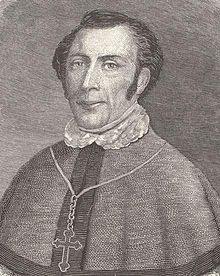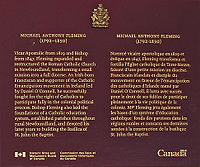- Michael Anthony Fleming
-
The Right Reverend Michael Fleming 
Archdiocese Archdiocese of St. John's Predecessor Thomas Scallan Successor John T. Mullock Personal details Birth name Michael Anthony Fleming Born 1792
Carrick-on-Suir, Tipperary, IrelandDied 14 July, 1850
St. John's, NewfoundlandBuried Basilica of St. John the Baptist Nationality Irish Denomination Roman Catholic Styles of
Michael Anthony Fleming
Reference style The Right Reverend Spoken style Your Excellency Religious style Monsignor Posthumous style none Michael Anthony Fleming (c. 1792 – July 14, 1850) was Catholic bishop of St. John's, Newfoundland. He was principally responsible for changing a small mission with several priests in four parishes into a large diocese with over 40,000 congregants and was the single most influential Irish immigrant to come to Newfoundland in the 19th century.
Michael Anthony Fleming was born about three miles from Carrick-on-Suir, Co. Tipperary, Ireland. As a boy, Fleming studied the classics for two years at Stradbally, Co. Waterford and entered the Franciscan seminary at Wexford. Fleming was ordained on October 15, 1815 and assigned to a friary at Carrickbeg. His experience in helping to rebuild the Franciscan chapel there marked him at an early age as a "builder", and stood him in good stead for his later work in Newfoundland.
In 1823, at the invitation of Bishop Thomas Scallan and the Benevolent Irish Society, Fleming was recruited to come and work as a priest in St. John's. From the outset, Fleming proved to be of a very different temperament from Scallan. His ideas about the place of the Irish and Catholicism in Newfoundland were informed by his experience of his close friend Daniel O'Connell's nationalist politics in Ireland. Soon after he was consecrated coadjutor bishop in the Chapel in St. John's in 1829, Fleming implemented his Ultramontanism ideology; he embarked on a systematic expansion of institutional Catholicism in Newfoundland. This included the construction of new parish churches, the subdivision of existing parishes into new parishes, the recruitment of Irish priests, and the introduction of two religious orders of Irish women to teach young female children. He took pains to visit outport Newfoundland, and during the winter of 1835 lived in a fishing room at Petty Harbour, administering smallpox vaccine to the whole community of Catholics and Anglicans, and remaining in quarantine with them when no physician or other clergyman would go there.
Fleming’s influence was not limited to the religious sphere. As Vicar Apostolic, and later as Bishop, he promoted the interest of the Irish Catholics in Newfoundland’s political sphere. Through petitioning the governor and the Colonial Office, Fleming was instrumental in enforcing the Emancipation Act for Irish Catholics in Newfoundland in 1832. In addition, with the parallel granting of Representative Government for the colony, Fleming was outspoken in the political process, lending support to candidates, both Catholic and Protestant, who furthered the rights and privileges he felt were important for the Irish Catholic population in the colony. Whether in church administration, education or political activities, Fleming’s bold actions and attitude marked a significant departure for the Catholic clergy in the Newfoundland colony.
Because of his deliberate political influence, Fleming, himself an “Irish nationalistic”, was viewed by many as a disruptive force in Newfoundland politics. He saw himself as the leader of the Irish community and was not shy about taking on the local British establishment, much as his friend and countryman Daniel O'Connell was doing at home, especially since he felt threatened by the Church of England's attempts to counteract growing Catholic influence. The struggle spilled over into inflammatory newspaper editorials, and lawsuits between increasingly bitter rivals. Tensions were made worse by the actions of partisans on both sides of the divide. Fleming intervened to get particular men elected, raising in the Tory minds the specter of a “priests' party” dominating the Assembly. From this point, church influence remained a dominant factor in Newfoundland politics from the 1830s onward.[1]
In popular though false legend, Fleming is credited with creating the "Pink, white and green" tricolour flag of Newfoundland. It is told that during annual wood hauls for the Anglican cathedral and Roman Catholic cathedral, considerable rivalry developed between the two groups involved. The Protestant English marked their wood piles with the pink flag of the Natives' Society, while the Catholic Irish used green banners. The threat of violence was such that Bishop Fleming intervened, and persuaded them to adopt a common flag , on which the pink and green would be separated by a white stripe to symbolize peace. The pink symbolized the Tudor Rose of England (The Protestants) and the Green symbolized St. Patrick's Emblem of Ireland (The Catholics). The White is taken from St. Andrew's Cross (St. Andrew is the Patron Saint of Fishermen and Scotland). This legend, it's symbolism and origins, have all been disproven by historical evidence. In reality, the Newfoundland "pink, white and green" tricolour didn't appear until at least 41 years after the inception of the Irish tricolour and was almost certainly based on the Irish flag.[2]
Fleming's greatest domestic projects, the ones for which he became best remembered, were the recruiting of two orders of Irish religious women to work as teachers, and the construction of a new cathedral for St. John's. In 1833 at Fleming's request, the Presentation Sisters came to Newfoundland from Galway and opened a school for children. Within weeks the sisters were inundated with new pupils, the children of the Irish of St. John's, who saw education as the best means of economic and social advancement. In 1842, Fleming invited the Sisters of Mercy to come to teach girls and to help create a Catholic middle class. Through Fleming's influence, the Education Act of 1836 introduced the precedent of granting state funds to denominations for educational purposes. In 1847, Bishop Fleming recruited four brothers of the order of Irish Franciscasns to come to Newfoundland to teach at the Benevolent Irish Society's school. Through the 1830s, Fleming pursued a grant of land on which to build a cathedral. By 1838 the land was awarded, and construction began, continuing until 1855. The cathedral was the largest building project in 19th century Newfoundland, and thereafter became the definitive icon of Newfoundland Catholicism.
On 9 September 2005, the 150th anniversary of the consecration of Fleming's cathedral, a plaque was unveiled by the Historic Sites and Monuments Board of Canada designating Bishop Fleming as a person of Canadian National Historic Significance.
Additional reading
- Fire Upon the Earth: A Biography of Bishop Michael Anthony Fleming, O.S.F. by Brother J.B. Darcy, ISBN 1-894294-59-9, Creative Press St. John's, Newfoundland
External links
References
- ^ "Representative Government, 1832-1855". http://www.heritage.nf.ca/law/representative.html. Retrieved 2010-06-29.
- ^ Newfoundland Tricolour
Categories:- 1792 births
- 1850 deaths
- 19th-century Roman Catholic bishops
- Canadian Roman Catholic bishops
- Canadian people of Irish descent
- Irish Roman Catholic priests
- Newfoundland and Labrador religious figures
- People from County Tipperary
- People from St. John's, Newfoundland and Labrador
- National Historic Persons of Canada
Wikimedia Foundation. 2010.


